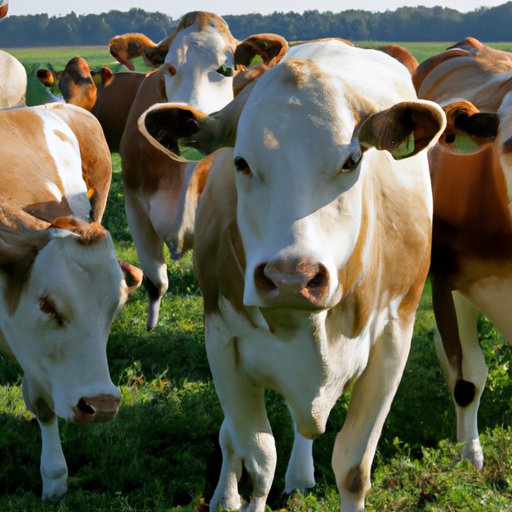Introduction
Cows, or cattle, are one of the most important animals in the world. Not only do they provide us with food, but they also contribute significantly to the global economy. As such, it is important to understand the size and distribution of cattle populations around the world and how they are affected by various factors, including geography, climate, and economic incentives.
Cattle are found in all parts of the world, but the majority of the world’s cattle population is concentrated in the tropics. The global cattle population is estimated at 1.5 billion, with the top five countries – India, Brazil, China, the United States, and Mexico – accounting for more than 50% of the world’s total. In addition, these countries are responsible for more than 70% of global beef production.
Statistical Analysis of Cattle Populations Around the World
According to data from the Food and Agriculture Organization of the United Nations (FAO), there were 1.49 billion cattle in the world in 2020. The regions with the highest cattle populations include South Asia (32%), Sub-Saharan Africa (25%), Latin America and the Caribbean (21%), and the Near East and North Africa (14%).
In terms of individual countries, India has the largest cattle population in the world with more than 300 million cows. It is followed by Brazil (223 million), China (156 million), the United States (92 million), and Mexico (86 million). Other countries with large cattle populations include Ethiopia (48 million), Pakistan (47 million), Nigeria (44 million), and Australia (31 million).

Exploring the Geography of Cow Herds and Their Impact on Local Economies
The geographical location of cattle herds has a significant impact on local economies. In many parts of the world, cattle herding is an important source of income for rural families and communities. For example, in Mexico, cattle ranching is a major source of employment and provides millions of jobs to rural Mexicans.
The landscapes and climates of different regions also have a major influence on where and how cattle are raised. In arid regions, for instance, such as the Sahel region of Africa, cattle herding is often the main source of livelihood. On the other hand, in tropical regions, such as Southeast Asia, cattle are primarily used for dairy production.
The Global Impact of Dairy Production: A Closer Look at Our Bovine Companions
Cows are not just important for meat production. Dairy production is also a major source of income for many countries. In 2019, the dairy industry was worth $1.2 trillion globally, with countries like India, China, and the United States leading the way in terms of production.
Dairy products provide essential nutrients to people around the world, and the industry contributes significantly to the global economy. In addition, dairy production also helps to reduce poverty in rural areas, as milk can be sold locally for a profit.
An Overview of the Economic Benefits of Cattle Farming
Cattle farming is an important source of income for many rural households. In fact, according to the FAO, small-scale farmers account for more than 90% of the world’s cattle herders. Cattle farming also provides employment opportunities, as well as access to food and nutrition for many people in developing countries.
In addition, governments around the world offer subsidies and other incentives to encourage cattle farming. These subsidies can help farmers invest in better facilities, feed, and veterinary care for their herds. This, in turn, helps to increase productivity and profitability, which can have a positive impact on local economies.

The Challenges Facing Cattle Ranchers in a Changing Climate
Climate change is having a major impact on the way cattle are raised around the world. Rising temperatures and changing weather patterns can lead to decreased grazing land, water shortages, and increased disease risk. As such, cattle ranchers must adapt their practices in order to survive in a changing environment.
One way to do this is through sustainable practices, such as rotational grazing, which helps to improve soil health and prevent overgrazing. In addition, alternative feed sources, such as crop residues and silage, can help to supplement grazing lands in times of drought and other adverse conditions.

The Role of Cows in Global Food Security: Solutions for an Uncertain Future
Cows are a vital part of global food security. As demand for beef and dairy products continues to grow, it is important to ensure that cattle production is sustainable and that we are taking steps to protect our bovine companions from the effects of climate change.
Sustainable practices, such as rotational grazing and the use of alternative feed sources, can help to improve the health of grazing lands and reduce the risk of overgrazing. In addition, government incentives, such as subsidies and tax breaks, can help to make cattle farming more profitable and accessible to small-scale farmers. Finally, research into new technologies, such as gene editing and gene drives, could help to improve the efficiency and sustainability of cattle production in the future.
Conclusion
Cows are an integral part of the global economy and play a major role in providing food to people around the world. Understanding the size and distribution of the global cattle population is essential for appreciating the economic and ecological importance of these animals. Furthermore, exploring how different climates, landscapes, and economic incentives affect cattle production can help us develop strategies for ensuring food security for future generations.
It is clear that cows are a valuable resource and that we must take steps to protect them from the effects of climate change. Sustainable practices, government incentives, and technological advances can all help to ensure that cattle production remains profitable and sustainable in the years to come.


